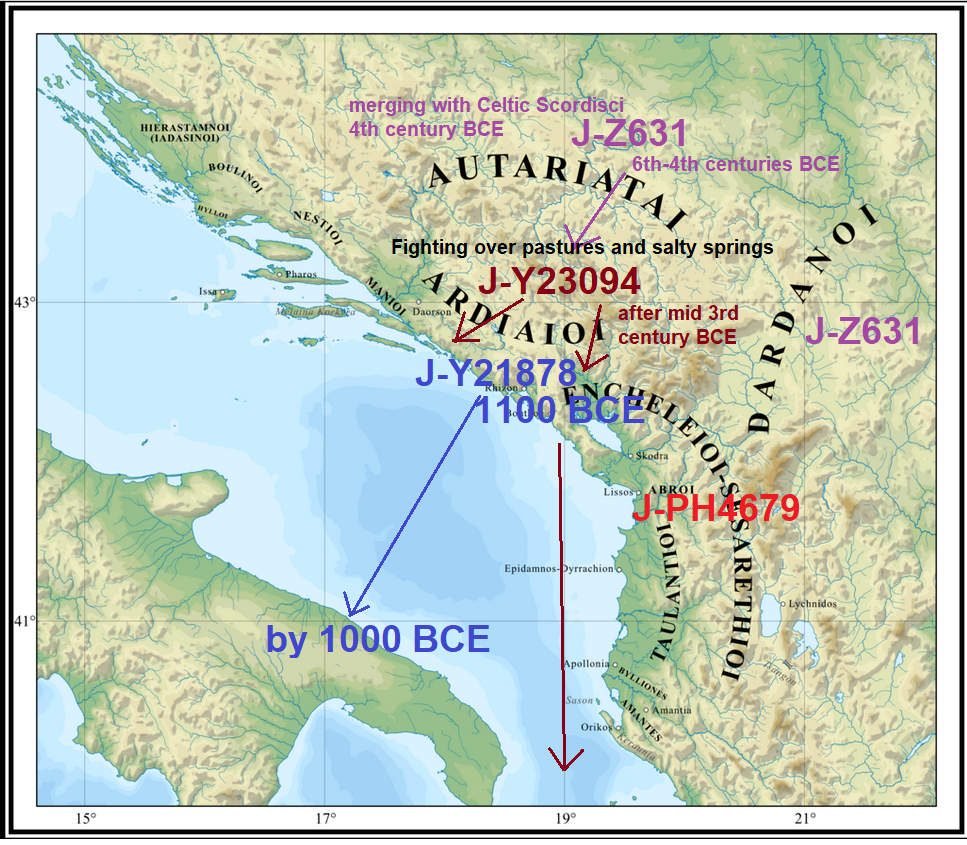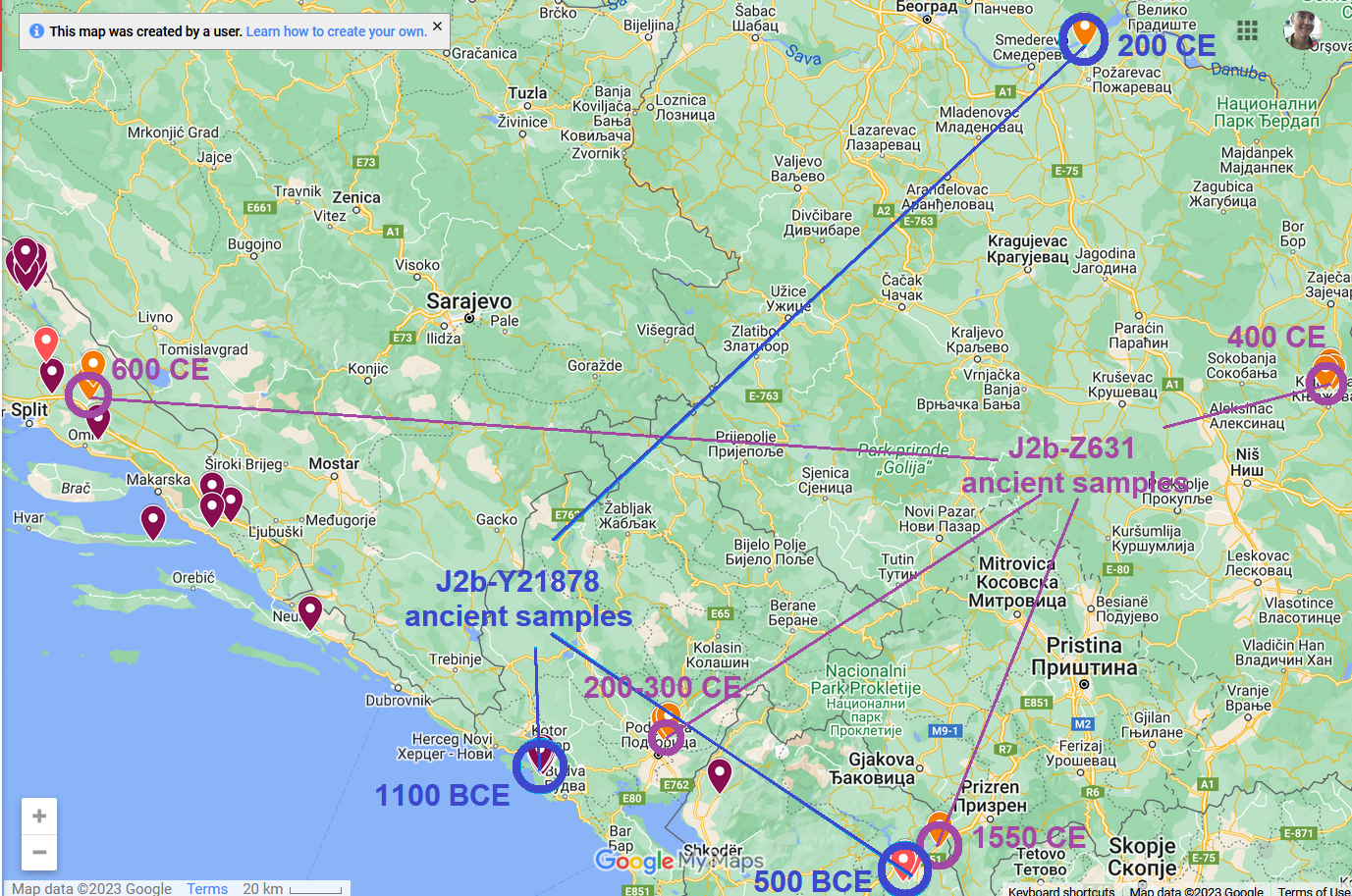We should keep a few things in mind before I explain my reasoning for speculating on approximate geographic origins of some of these subclades of 4200 year old J2b-Z638.
The original map I am using supposedly depicts tribes as they were known in the 7th-4th centuries BCE.

However, the subclades I have written on the map are all older than this, having Most Recent Common Ancestors who lived:
- J2b-Y21878 3700 ybp
- J2b-Y23094 3100 ybp
- J2b-PH4679 3100 ybp
- J2b-Z631 3000 ybp
So rather than thinking that these entire tribes consisted of 100% of the respective subclade I have written nearby on the map, consider those locations as my proposed approximate relative epicenters. After several hundreds of years these male lines may have radiated out in every direction so that, by the late Iron Age, each subclade could actually have been found in each tribal confederation.

Notwithstanding, I am willing to share this map based on my interpretation of some key differences I find in the ancient and modern distribution of these lineages together with historical sources about the late Iron Age geopolitics of the western Balkans.
The word relative I have italicized because these locations were chosen by me personally in an attempt to match a subclade to a known Iron Age tribe's known historic geography rather than by some objective software.
It could actually be the case that several of these subclades originated in the exact same place rather than each in a different location.
J2b-Y21878 on this map is not speculation
Based on Late Bronze Age samples I13167 found in Velika Gruda, Montenegro and NEO806 in Monopoli, Italy we know that this lineage was living in these areas by the Late Bronze Age.
Ardiaei supposedly originally lived inland before becoming a coastal power
Samples of J2b-Y23094 have not yet been found in a Bronze Age context. Given that the ancient Adriatic Coast has been heavily sampled so far, we may tentatively assume that J2b-Y23094 was not originally living along the coasts.
However, it has a child line J2b-YP26 that is so far only found in sea-mediated locations like Kefalonia, Sicily and Sardinia. The TMRCA of this line is estimated at 2100 ybp.
I do not know the ancient source he bases his analysis on, but Mesihovic (2014) claims that the Ardiaei were not originally a coastal people. Allegedly they had been at war with the Autariatae over salt resources and pastures near their original, highland homeland. From Wilkes (1992), p223:
"The salt source that was a cause of conflict between the Illyrian Ardiaei and Autariatae may be that at Orahovica in the upper Neretva valley near Konjic."
They did however, under King Agron in 230 BCE, come to control a large coastal federation. From Appian, Illyrian Wars, Chapter II, section 7:
Agron was king of that part of Illyria which borders the Adriatic Sea, over which sea Pyrrhus, king of Epirus, and his successors held sway. Agron captured a part of Epirus and also Corcyra, Epidamnus, and Pharus in succession, where he established garrisons.
So if we believe Strabo, Mesihovic, and Wilkes, the limited circumstantial genetic evidence would make J2b-Y23094 perhaps our best J2b-L283 subclade fit for the Ardiaei tribe, an originally inland tribe that later dominated the coasts, differences in TMRCA notwithstanding.
The aftermath of the Ardiaei according to Strabo:
Because they pestered the sea through their piratical bands, the Romans pushed them back from it into the interior and forced them to till the soil. But the country is rough and poor and not suited to a farming population, and therefore the tribe has been utterly ruined and in fact has almost been obliterated. And this is what befell the rest of the peoples in that part of the world; for those who were most powerful in earlier times were utterly humbled or were obliterated, as, for example, among the Galatae the Boii and the Scordistae, and among the Illyrians the Autariatae, Ardiaei, and Dardanii, and among the Thracians the Triballi; that is, they were reduced in warfare by one another at first and then later by the Macedonians and the Romans.
Autariatae
From Wikipedia attributed to Wilkes (I didn't yet order the book but I plan to):
Activities of the Autariatae at the turn of the 6th and 5th centuries BC profoundly influenced the peoples who were directly affected by their expansion. The Ardiaei were moved toward the coasts and the Triballi to the east. The expansion of the Autariatae enabled them to achieve hegemonic control over one part of the interior of the Balkan Peninsula.
The leading class of the Autariatae society reached the peak of its political and economic development indicated through many great luxurious royal tumuli and graves created during the 5th century BC. Strabo’s comment on the Autariatae as "the once greatest and most powerful Illyrian people" most likely refers to this period. Their peak of development was followed by the gradual decline of the Autariatae ending in 310 BC with their sudden disappearance[14] due to Celtic migrations.
J2b-Z631 through prolific child J2b-Z1043 is a good candidate for an inland, hegemonic tribal confederation, because
- it is the most prolific lineage of J2b-L283
- it has not been found in a Bronze or Iron Age ancient context along the heavily sampled coasts
- it has not been found in heavily sampled Sardinia
- the oldest ancient samples from the Balkans in this line are from near Podgorica and Timacum Minus, not along the coast [edited 4/2/2023 to include R3481 from Podgorica]
The Autariatae were eventually defeated by the Celtic Scordisci and then merged with them, adopting some Celtic customs.
Dardani
The third of Strabos 'big three' ancient Illyrian tribes. This tribe seems to have kept its identity longer due to favorable geopolitics.
I marked J2b-Z631 as also near the homeland of the Dardani because of the ancient J2b-Z1043 sample from Timacum Minus.
Dardani were recruited heavily by the Roman army over several centuries.
If the Dardani were mostly J2b-Z631, it is interesting that this lineage was nearly completely replaced in its homeland, likely over a relatively short period of a few hundred years culminating with the arrival of the Slavs.
Taulantioi and Encheleioi-Sesarethioi
There are a smaller number of Iron Age lineages of J2b-PH4679 to work with, yet the distribution skews very heavily toward Albania compared to the other subclades.
There are only four surviving lines older than 2000 years:
- An Albanian representing J-Y197646
- A Spaniard representing J-Y161916
- An Albanian representing J-Y161916
- Albanians representing pre-J-Y20899
So I mark J2b-PH4679 on this map to represent the approximate modern geography of Albanian speakers.
There may not yet be a statistically strong enough conclusion to be made, on the paucity of the surviving lineages, but based on the limited data, these men's ancestors were much less likely to migrate far afield as their cousins.
The conclusion I make is that this had something to do with the geographic origin of J2b-PH4679 not being a favored Roman army recruiting location / not being a vulnerable place that one would be likely to flee from during many subsequent invasions of the Balkans (these picked up in the 3rd century CE and culminated with the Slavs).
Additional Donations Required to Fund J2b-Z638 Sample From Montenegro
I have been testing our sample from Njeguši, Montenegro for individual SNPs at YSEQ. Yesterday came the interesting result that he's negative for Y21878.
So he is not more closely related to the ancient sample from Velika Gruda mentioned in this article.
The next SNP I'm testing him for is Z1297.
As soon as I get enough donations to cover the previous two tests I have already ordered, I will order the WGS for this sample.
You can see the current status of the fundraiser here - https://phylogeographer.com/j2b-l283/
J2b-L283 Xmas WGS wish list - https://phylogeographer.com/j2b-l283-christmas-2022-wgs-upgrade-wish-list/
You can donate to the fund via this link, specify "J2b-L283 WGS" in the comment - https://www.paypal.me/phylogeographer
Update 4/2/2023
I have updated the map of ancient samples above to include the oldest J2b-Z631 sample, R3481, a J2b-Z1043 positive ancient sample from Doclea Bjelovine, north of Podgorica.
The classification of the modern sample from Njegusi has been confirmed via a la carte SNP testing to be J2b-Z1043+. So he may represent genetic continuity in the region since at least the 3rd century CE if he ends up being more closely related to R3481.
Interesting read!
Though I’d like to point out that the oldest Z1043 sample thus far is in fact ID R3481 from Late Antiquity, Doclea Bjelovine, Montenegro 211-320.5 CE (~266 CE) J2b-L283>>Z615>Z597>Z638>Z1297>Z631>Z1043 (SNPs Z1048/CTS9038+,Y161465-,BY200348-,
Y183338-,Y105578-,Y26712-,PH1080-,FT212328-).
Yes thanks for pointing this out. An oversight on my part. I will soon update the map to show this sample from Doclea.
information on
Autariatae —- They originated in northern Bosnia and in ancient times joined up with the Celts in the failed attack on Delphi Greece, the remnants settled in southern Serbia
Encheleioi-Sesarethioi —— As some historians state they originate in coastal Montenegro and moved to western Macedonia circa 550BC
Taulantioi —– Never lived south of Durres ………Durres always was Epirote lands belonging to one of the 14 Epirote tribes……Epirote lands ranged from Durres to the entrance of the gulf of Corinth………………but we all know, Durres was created by Corinthian Greeks circa 720BC , same Greeks that took Corfu from the Liburnians in 735BC
regards
[url=https://postimages.org/][img]https://i.postimg.cc/9fnJTk7B/liburn-lembs.png[/img][/url]
The English-Croatian study in early 2022 shows in the above map, related people in yellow and white fonts………the white font tribes disappeared and formed the Illyrian Kingdom ( in yellow fonts ) ………..the others in yellow fonts remained.
Very informative as always. In the case of my lineage of J-Y23094 I think I can rule out the Ardiaei seeing as they were never used as auxiliaries in the Western Provinces as far as I’m aware. Unless they ended up merging with other surrounding tribes such as the Delmatae or Breuci.
This article is interesting and reinforces the curiosity of tribal genetic origins from the ancient Illyrians.
How do you imagine fitting the other lineages that were children of Z631 into this map?
Could Y87605 have been one of the first to disperse north with the Celts?